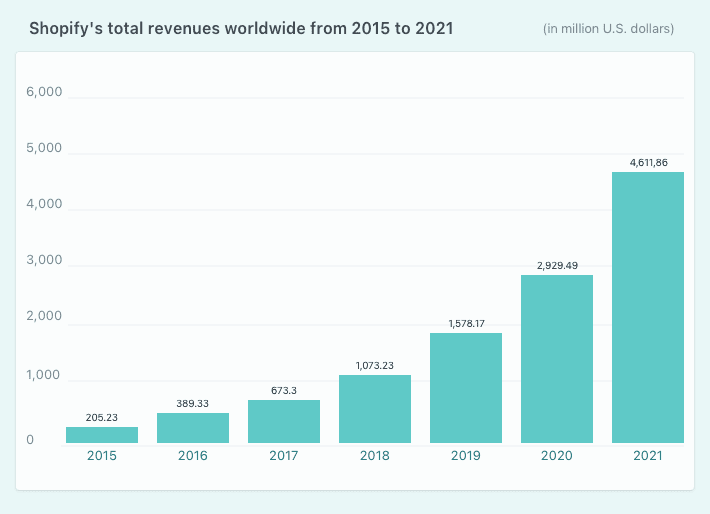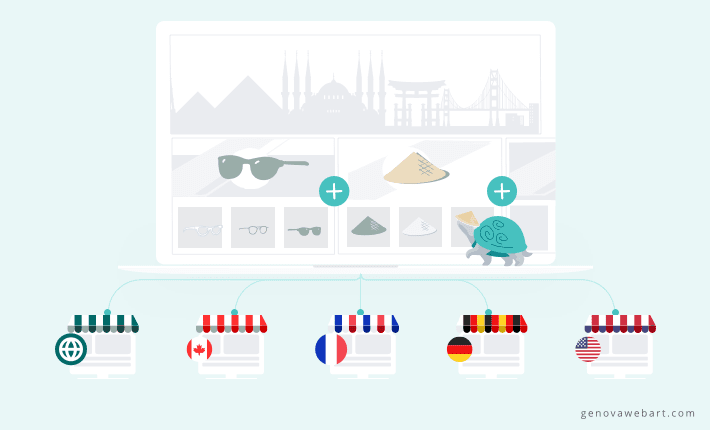Managing an online store locally is one thing. Yet, turning it on to sell to international customers is the level-up not everyone will dare try. Even fewer will succeed. What’s the biggest challenge? Choosing a reliable eCommerce platform. International commerce on Shopify is a splendid way to have everything done and managed in one place.
The online businesses joining the platform are growing yearly, and as of July 2022, Shopify owns 10% of the global eCommerce market. Sounds impressive, right? Shopify’s worldwide reach has spread to 175 countries, and it doesn’t seem they’re going to slow down the pace. Hence, it’s a good opportunity to join the club and benefit from it.
And here the second challenge comes — to organize everything smartly to work exactly for you.
You can learn the drill on how to set up Shopify for international sales yourself, but that would be challenging and time-consuming. Or come to the professionals - GenovaWebArt - and we’ll help you do it quickly, efficiently, and without errors.
In this article, we will share how to sell internationally on Shopify without compromising the business goals, shoppers’ needs, and quality of project realization. So keep on reading to get all your questions answered and your doubts dispelled!
Table of Contents
- Why Should You Get into International Selling on Shopify?
- 5 Things to Consider Before Selling on Shopify Internationally
-
How to Set Up Your Shopify Store for Cross-Border eCommerce?
- Check your readiness to sell cross-border
- Define your key goals for expansion
- Make sure your resources can handle it
- Determine the new target market
- Set up your Shopify store for international sales
- Learn the tax nuances typical of the new geo
- Investigate the customs regulation of the new market
- Choose the optimal shipment method
- Localize your store
- Take care of invoices
- How GenovaWebArt Can Help You Sell Internationally on Shopify
- Final Thoughts
- FAQ
Why Should You Get into International Selling on Shopify?

Do you need a motivational push to action before you start selling your goods to the new foreign markets? Quite expected. All right, let’s replace your initial concerns with pure facts. First, consider the revenue boost you can get while playing big with international sales on Shopify.
Read more: A Comprehensive Guide to A/B Testing on Shopify
Go and check the statistics
Numbers speak louder than any words, don’t they? Look at the latest research from Statista about Shopify international sales to grab more motivation for a start.

As you clearly see from the picture, in 2021, Shopify surpassed the bar of $4.6 bn in total revenues, which shows the gradual and confident jump since 2015 — 205 mln.
Search for the reasons under the trend
So, what’s the hype over cross-border ecommerce for Shopify? Mainly, it’s about the all-in-one solution convenience as the platform combines a sale system, payment gateways, tax calculation tools, international shipping options, and email marketing functionality.
Also, Shopify is popular due to its universal character: it perfectly helps eCommerce businesses of different sizes, goods specifics, and industry belonging. Read more: 30 Best Shopify Clothing Stores: 2022 Edition
Another ‘why’ to fuel your curiosity in serving customers from multiple countries is risk reduction. What if we’d say that 35% of all Shopify order requests come from international shoppers? By selling the goods to different cross-border locations, you’ll ensure your store is more than afloat. Diversification has always been a ground for financial stability. Nothing has changed, Shopify international sales are guaranteed to help reduce risks.
5 Things to Consider Before Selling on Shopify Internationally
Now when you’ve got enough reason to try international ecommerce on Shopify, it’s time to get to the details on how to prepare for a big dive. Before you plunge into this new experience with enthusiasm, check our experts’ recommendations first.
Add local currencies
Though the majority of merchants on Shopify are from the US, it doesn’t necessarily imply that USD currency suits all equally well.
For instance, Europe is the second target market, in which the online stores willingly put their business development efforts on Shopify. Hence, don’t disappoint your potential buyers by not finding the convenient option on the list.
To find the golden mean for both sides, it’s better to integrate the. payment system, such as Paypal, as the perfect payments alternative. In this case, your customers will be flexible in choosing a currency that suits them best (among the 25 available options). You’ll succeed in retaining the newcomers and stirring their loyalty to your brand. A win-win scenario, isn’t it?
Vary types of payment
This factor is tightly related to the previous one, but this time we’ll look deeper at various payment methods. Before making a purchase, customers are usually interested in the convenience of the money transfer. Here, serving different markets becomes already a challenge as you need to do proper research on the preferable payment choices for each.
For instance, let’s have a look at the UK. In this location, most online shoppers prefer paying through digital wallets, such as Klarna, whereas debit and credit cards also remain high in popularity. Or, let’s take another example — Australia. As of 2021, almost half of purchases were made by cards, while the attitude to bank transfers was quite skeptical (only 8%).
Do you see now how diversified your payment options should be? Pay attention to it!
Make native translations
While you may consider that almost everyone speaks English or can translate some buttons and step explanations with Google Translate, you’d better not rely on this too much. Remember that we’re living in a time when the user experience is the determining factor in choosing the place for online shopping. Don’t ignore localization!
Moreover, buying something isn’t the only thing users need from you. In reality, they expect a more varied list of ‘wants,’ including reading interesting region-specific news, seeing the expert articles in your blog, or reading product descriptions in their native language. Hence, to raise conversions, you shouldn’t only translate the content but also dig in for more.
Choose the trusted shipping method
Another factor you should think over beforehand is the choice of the shipping partner to start selling internationally on Shopify.
Take a look at FedEx if you aspire to enjoy discounts and free packages, take easy control over all the deliveries, and be sure of the safety of selling goods.
If you want cheaper options and reduced shipping costs, try a price comparison tool such as ShipStation. With it, you’ll clearly define your rates and select the best carrier to let your eCommerce business easily migrate to the new markets. Balance your spending with proper reliability and carry on!
Examine the international guidelines
Last but not least is the account for the various regulations typical of each target market. At this stage, you should thoroughly investigate what limits and rules the country imposes for importing, exporting, and distributing goods. You may also ask for professional consulting on this question from big players like A Group Consulting or BearingPoint.
If you have a limited budget for this research, you may also find an expert on Upwork. However, you should be twice more careful when choosing a specialist here. Not to error, we’d recommend you weigh relevant experience and check clients’ reviews carefully.
How to Set Up Your Shopify Store for Cross-Border eCommerce?

Now when you’re equipped with the basic knowledge of how to start with global ecommerce for Shopify, we can guide you to the depth of the issue. Let’s look closer at how to set up international selling on Shopify step by step!
1. Check your readiness to sell cross-border
Do you think you can skip this step and go right to #2? Please, don’t do this! Though it may appear redundant, it’s actually not. Don’t want to deal with the consequences of failure? You'd better make a pause here. Think over the current state of business affairs when you sell the goods on a local scale. Go to the deep analysis to support your opinion with figures and facts.
After looking through the site analytics, sales statistics, and revenue reports, ask yourself a question — do I have a good hold on my home market? If you feel confident in serving the local market well, with proper quality and two-way communication, please, do continue.
2. Define your key goals for expansion
Well, now believing in power in your hands, you should search for your own ‘why’ to play big and try to expand your business to the new market. For instance, you can be thrilled by the idea of reaching the brand’s visibility for a bigger number of customers. Or you can wish to automate the buying process for increased sales. Choose yours!
Whenever it’s ready, consider two options for going further. The former is to add a new section for the new country in the existing webstore. Use Shopify Markets to get it done! The latter is to open the new store if you’re going to delegate its running to the third party by a franchise. In this case, we’d recommend using Hreflang Manager to consider the nuances of International SEO.
3. Make sure your resources can handle it
To sell internationally with Shopify, you should be sure that your available team can cope with the task. Estimate the resources you need for preparation, realization, and further communication with newly appeared clients. Will you go through with all this by your means? Or is it better to hire a few employees to help you support the expansion process on the go?
Besides, consider the budget to set your priorities right at this stage. Need professional consulting with your Shopify store? Come to GenovaWebArt, and we’ll proceed with the in-depth discovery to use your resources efficiently.
4. Determine the new target market
It’s another critical step that requires grounded analysis on your side. Don’t blindly repeat what the others do! Instead, cherry-pick among the options that seem promising exactly for your store. How would you know it? Check Google Trends to identify popular user requests in a particular market and weigh the demand for your products there. Start with it!
As a result, you’ll end up with the best options to try for Shopify's international expansion. Investigate each market one by one, comparing the points stated in ‘5 Things to Consider Before Selling on Shopify Internationally.’ Select the one that you find the best fit and move forward!
5. Set up your Shopify store for international sales
All right, the choice is made, and we’re finally going to the ‘meat’ of the job. The platform already gives you all the inventory you need, and all that is left is to set it up according to your store’s needs. First, Shopify markets add the new countries/regions where you’ll sell your goods. Second, they let you go to the additional settings — from domains to payment options.
After the basic features are done, you can switch to the advanced settings. Namely, choose here between manual and automatic exchange rate calculations. Plus, you’ve got an opportunity to add the selected languages for customers to see and read the content in their native languages.
Now you’re almost ready, but not yet. Keep it up!
6. Learn the tax nuances typical of the new geo
Slow down here for a moment! To ensure your online eCommerce business is run smartly and risk-safe, you should comply with the tax rules of each market. In case it’s a new one, learn everything thoroughly. Read the information only on governmental websites (like this one or that one) to catch the taxation details that are up-to-date and trustworthy.
You can also address the tax professional to clarify everything to get it right. The benefit of such consulting is gaining valuable insights relevant to your specific service. Prior investing is better than paying considerable sums for doing something wrong.
7. Investigate the customs regulation of the new market
Complying with the taxation rules is one thing, but accounting for each country’s customs regulations is another. So, be ready to spend some time digging into this side of the question too.
Begin with import or export restrictions for your products. Then work on keeping all necessary documents to make the regular international transfers legal. Custom declarations are the main permits to let your products cross the border, but export invoices should also be part of the package in some cases. Check all the local regulatory nuances in advance!
8. Choose the optimal shipment method
A safe, timely, and cost-efficient delivery of your products to buyers is one of the puzzles to gather the whole image of successful cross-border shopping. That’s why selecting the shipment method should be another well-thought decision on your list. Remember that customer acquisition usually comes with the first impression. Don’t break the magic!
Eager to know how to sell internationally with Shopify in terms of delivery? First, choose a reliable international provider that suits your budget.
Second, use carrier-calculated shipping to avoid any unpleasant surprises for your customers. Third, integrate it with your Shopify store. Finally, update your shoppers on the go with automated tools like AfterShip.
9. Localize your store
Multilingual stores aren’t the dream anymore. It’s already the reality for the 2022’s shoppers. Have you heard that 46% of eCommerce websites provide translated versions in 4 or more languages? If you truly strive for international sales on Shopify, consider joining their rows.
But remember that localization isn’t only limited to content translation. You should also incorporate the knowledge of your TA into your verbal appeals, marketing ads, and the whole leads generation strategy. To truly excel in the global market, consider crafting a compelling lead magnet on Shopify that resonates with your diverse audience, leveraging both language and cultural nuances to maximize engagement.
10. Take care of invoices
We’ve already mentioned invoices while covering the aspect of customs regulation. Here, we’d like to emphasize it separately as the final step of getting ready to sell internationally.
As you usually don’t have a physical store in their scope of reach, the new clients would probably like to check your safety through invoices. That’s the usual practice, and you don’t have any concerns about it. Just put down the relevant company’s information, date of order, and amount paid, and that’s it. To make these docs quicker, try Invoice Falcon.
How GenovaWebArt Can Help You Sell Internationally on Shopify
With us, you can receive qualified consulting to prepare your store for international sales on Shopify. But not only that! We’re ready to put this theory into practice and strengthen your brand identity with our design and development services.
Need some examples? Check our clients who started with one store and now can boast of having a few of them in different countries:
- Paper Republic — opened their stores in Germany, France, the US, and Great Britain;
- Ten Thousand — expanded their business to the Canadian market;
- KIT & KIN — opened their stores in the US, Ireland, Holland, and Australia;
- Early Rider — added the US and Switzerland to the list of their eCommerce reach.
We can do the same kind of job for your Shopify store. Contact GenovaWebArt, and commit to your brand’s recognition in the new regions!
Final Thoughts
It’s never too late to try something new and dare to enter the new market with your Shopify store. The more you know about your exact business, the lesser it’ll be. Anyway, spend some energy and time learning as much as possible about this new region: shipment, regulations, tax policies, cultural peculiarities, etc. The more you know, the easier it’ll flow.
However, you don’t need to do all this research and set up a job yourself. GenovaWebArt is ready to help you with the Shopify app customization for the new market. Come to us, and we’ll acquire the new regions together!



![Shopify Sales Channels [Complete Guide] - GenovaWebArt blog article, banner image Shopify Sales Channels [Complete Guide] - GenovaWebArt blog article, banner image](https://genovawebart.com/hubfs/img/webp/hero-banner-blog-article-shopify-sales-channels.webp)



